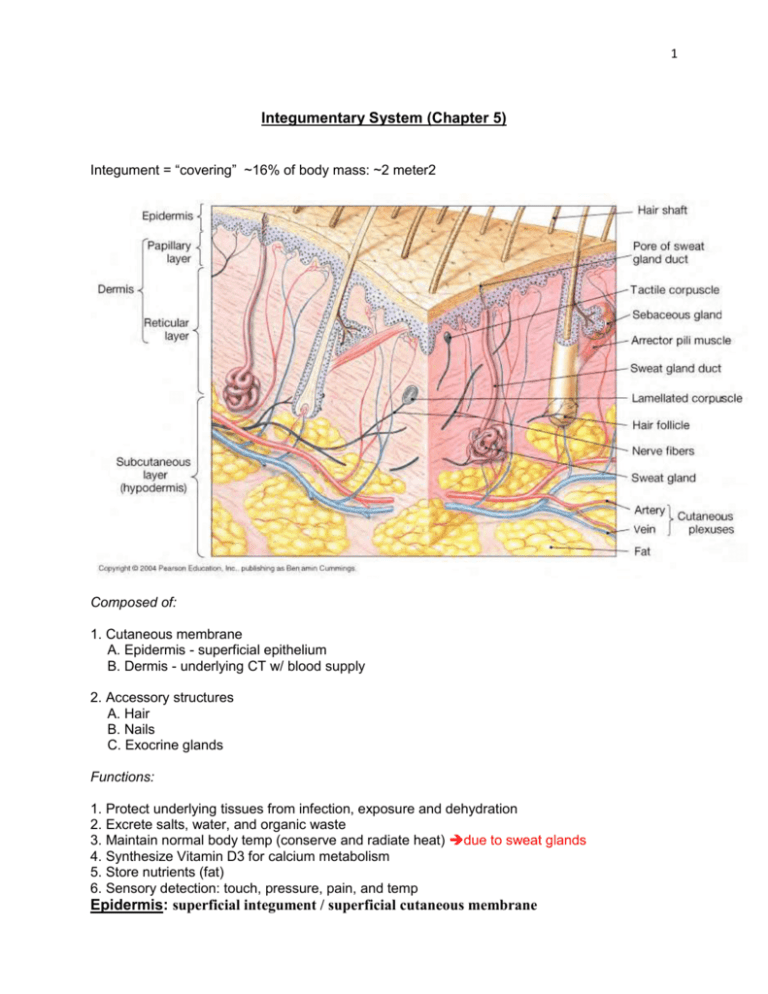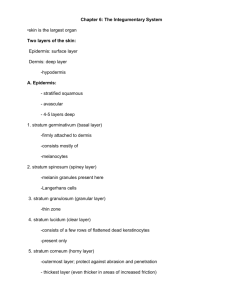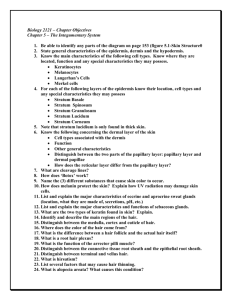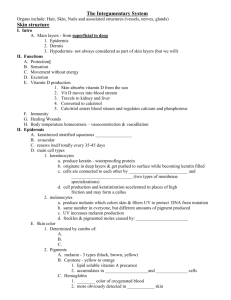thick basal
advertisement

1 Integumentary System (Chapter 5) Integument = “covering” ~16% of body mass: ~2 meter2 Composed of: 1. Cutaneous membrane A. Epidermis - superficial epithelium B. Dermis - underlying CT w/ blood supply 2. Accessory structures A. Hair B. Nails C. Exocrine glands Functions: 1. Protect underlying tissues from infection, exposure and dehydration 2. Excrete salts, water, and organic waste 3. Maintain normal body temp (conserve and radiate heat) due to sweat glands 4. Synthesize Vitamin D3 for calcium metabolism 5. Store nutrients (fat) 6. Sensory detection: touch, pressure, pain, and temp Epidermis: superficial integument / superficial cutaneous membrane 2 -Stratified squamous epithelium -Avascular bec. it is not thick---------it is nourished by diffusion from capillaries of dermis -Mostly keratinocytes: cells filled with soft keratin protein reduces water loss - Other cells: Melanocytes: skin color Langerhans cells: part of immune system Merkel cells: associated with nerve endings & responsible for detecting light touch & superficial pressure -Two types: 3 1. Thick skin - up to 0.5mm, 5 layers, no hair, palms and soles found in areas subject to pressure or friction 2. Thin skin - 0.1mm or less, 4 layers, usually hairy, most of body No stratum lucidum each stratum contains fewer layers than thick skin Layers: (from deepest to most superficial) Stratum basale - single layer, attached to basal lamina by hemidesmosomes (anchor), extends into dermis as epidermal ridges (dermis= dermal papillae), cells mostly basal/germinative cells (stem cells) that constantly divide, some melanocytes (melanin), some Merkel cells in hairless skin (touch receptors) also called Stratum Germinativum Stratum spinosum - 8-10 layers keratinocytes attached by desmosomes, some cells can divide, some Langerhans cells present (immune response) as cells are pushed to surface------they flatten ( desmosomes break apart & new desmosomes form) also has Lamellar Bodies------------lipid filled (formed inside keratinocyes) Stratum granulosum - 3-5 layers keratinocytes producing keratin fibers, keratohyaline granules (protein granules), and lamellated granules (lamellar bodies release their lipid), no cell division, nuclei and organelles begin to disintegrate Cells begin to die 4 Stratum lucidum - thick skin only, flat packed keratin filled keratinocytes appears clear several layers of dead cells--------keratohyaline granules are dispersed, so can’t see them Stratum corneum - 15-30 layers dead keratinocytes that have been keratinized (cornified-dead cells with hard protein envelope): soft keratin fibers glued in parallel arrays by keratohyaline, extracellular space filled with glycolipids from lamellated granules (cornified = water and chemical resistant) cells are surrounded by lipids---------responsible for permeability of skin -Transit from stratum basale to stratum corneum: 15-30 days -Duration at stratum corneum: 7-14 days -Complete turnover every 25-45 days *Note: Skin has soft keratin Hard keratin is found in nails, external part of hair (does not desquamate-----slough off) -The corrugated border between dermis and epidermis helps bond epidermis to dermis (increased surface area for attachment) -In thick skin epidermal ridges show on the surface as fingerprints: function to enhance gripping 5 -Epidermis water resistant but not water proof: -Insensible perspiration = water loss through epidermis: ~500ml (1 pint) / day (more if damaged, ex: burn) -Callus = thickening of epidermis, due to repeat friction (Stratum Corneum layers increase greatly) -Blister = separation of epidermal layers or epidermis from dermis, space fills with interstitial fluid Skin Color: Pigment based: epidermal pigments and blood pigments contribute to the color 1. Epidermal Pigmentation A. Carotene: yellow-orange, from diet -converted into Vitamin A -localized to epithelium -functions in normal maintenance of epithelia and photoreceptors -excess accumulates in stratum corneum (skin has yellowish tint) B. Melanin: brown, from melanocytes -for UV protection Melanocytes: in stratum basale -synthesize melanin (amount, genetically determined) from tyrosine (amino acid) -packaged in melanosomes -transferred to cytoplasm of keratinocytes -cluster around top side of nucleus -eventually digested by lysosomes 6 Areas where melanin is: More: Freckles Moles Nipples Areolae of breast Genitalia Less: Lips Palms Soles -Everyone has ~1000 melanocytes /mm2: -pale people: small melanosomes, present only in stratum basale and spinosum -dark people: larger, greater number of melanosomes, retained up through stratum granulosum -Freckle = overproduction of melanin from single melanocyte -UV exposure: -some needed for Vitamin D3 production -excess = damage (DNA mutation) -fibroblasts → altered CT structure, wrinkles -epidermal cells, melanocytes → cancers: squamous cell carcinoma melanoma 2. Dermal Circulation: hemoglobin pigment -oxygenated blood = red color, hemoglobin in RBCs, through skin looks pink *vasodilation → skin looks more red *vasoconstriction → skin looks more pale -Cyanosis = low oxygen, blood deep purple, skin appears blue/purple results from low temp, heart failure, asthma Shock -Erythema = increase redness of skin (increase blood flow) Ex: infections, sunburn, insect bite, anger, blushing Abnormal skin color: -Jaundice: liver fails to excrete bile, accumulates in skin, yellow -Addison’s Disease: pituitary secretes excess adrenocorticotropic hormone (regulates blood glucose), stimulates melanocytes, excess melanin, bronzing -Albinism: genetic mutation in melanin biosynthesis pathway, lack pigmentation in skin, hair and eyes inability to produce amino acid enzyme, tyrosinase -Vitiligo: autoimmune disease → destruction of melanocytes white patches on skin 7 Vitamin D3 Production: -Cells of stratum spinosum and basale UV energy + cholesterol (7 dehydrocholesterol) = Vitamin D3 (cholecalciferol) -Vitamin D3 used by kidney to synthesize the hormone calcitriol -Calcitriol necessary to signal small intestine to absorb calcium (keep it in blood) -No VitD → no calcitriol → no calcium absorption → weak bones -Contain Vitamin D: liver, egg yolks, dairy Dermis: deep integument / deep cutaneous membrane -Contains: all cells of CT proper (fibroblasts, macrophages), accessory organs of integument (hair follicles, sweat and sebaceous glands), blood vessels, lymphatic vessels, nerves, sensory receptors -Dermis highly vascularized: must “feed” itself and epidermis above -Contusion = bruise, trauma that ruptures blood vessels but does not break skin, blood pools in dermis and must be removed by phagocytes (slow process) 8 -Two layers: 1. Papillary layer (superficial layer): thin (20%), areolar connective tissue, comprise dermal papillae, functions to feed epidermis contains blood vessels 2. Reticular layer (deeper layer): thick (80%), dense irregular connective tissue, elastic and collagen fibers, functions to provide strength and flexibility -Collagen fibers blend into papillary and subcutaneous layers to attach integument to body -wrinkles = dermis stretched beyond its elastic capacity, collagen fibers damaged -stretch marks = collagen & elastic fibers torn (overstretched) -collagen & elastin fibers arranged in parallel bundles aligned to resist the expected direction of force = lines of cleavage 9 Sensory perception in integument: Skin highly innervated for sensory perception, mostly in dermis: 1. Merkel cells – deep layers of epidermis, superficial touch 2. Free nerve endings - superficial dermis, pain and temperature (itch & tickle) 3. Meissner’s corpuscles - superficial dermis, light touch detects simultaneous stimulation at two points on skin 4. Pacinian/Lamellated corpuscles - deep dermis, pressure and vibration deep pressure 5. Ruffini end organs – continuous touch or pressure Subcutaneous Layer a.k.a. Hypodermis: -areolar and adipose CT -tightly interwoven with reticular layer of dermis -not part of cutaneous membrane (not part of skin) -stabilizes position of skin while permitting independent movement of skin and muscles -children: even layer of adipose -puberty: adipose shifts male: neck, arms, abdomen, lower back female: breast, buttocks, hips, thighs -no vital organs: safe for “SubQ” injection, vascular for quick absorption (attaches to underlying bone & muscle) 10 Accessory Structures of the Integument: 1. Hair follicles and hair 2. Sebaceous glands 3. Sweat glands 4. Nails All of these structures are anchored in the dermis but are derived from epidermal tissue Hair: -Human body: ~2.5 million hairs, 75% on body -Everywhere except: palms, soles, lips, and certain genitalia -Hair itself is dead, but is derived from live epidermal tissue -Hair and Hair Follicle Structure 11 Hair Follicle structure: -Hair follicle - tube of stratified squamous epithelium anchored in dermis; surrounds, supports and produces hair; two layers: -Internal root sheath - contacts hair -External root sheath - contacts glassy membrane -Glassy membrane - thick basal lamina between epithelial follicle and connective tissue dermis -Hair bulb - expanded base of follicle where cell division occurs; surrounds papilla and matrix -Hair papilla - connective tissue at base of bulb; contains capillaries and nerves; supports matrix -Hair matrix - dividing epithelial cells and melanocytes above papilla that form new hair Hair structure: -Hair root - embedded in dermis; not yet fully formed; contains live cells -Hair shaft - pokes through epidermis; fully organized dead hair; three layers: -cuticle - outermost; overlapping dead keratinized cells form shiny surface -cortex - middle layer; dead cells contain hard keratin (contains a lot of sulfur-----so, bad smell when hair burns) to provide stiffness -medulla - core; dead cells contain soft keratin and air to provide flexibility 12 -Shape of the shaft determines feel: -flattened shaft = kinky hair -oval shaft = silky and wavy hair -round shaft = straight and often stiff hair Two types of hair produced: 1. Vellus hairs = “peach fuzz”, short & fine -lacks medulla -covers body, at puberty hormones can trigger switch to terminal hairs 2. Terminal hairs -thick, coarse, pigmented -all three layers Hair Color: -range yellow (little melanin) to black (mostly melanin) due to melanin from melanocytes in hair matrix -red hair: red type of melanin (pheomelanin)--------also found in lips, nipples, vagina -melanin stored in cortex and medulla With age, melanin declines, air pockets in medulla increase = gray or white hair (no melanin) Hair Growth: ~0.33mm/day, not continuous: cycle of growth and rest 1. Active phase (Growth phase): new hair added to hair root by dividing cells of hair matrix (weeks-years) 2. Regressive phase: cells of hair matrix stop dividing, hair root and hair papilla separate loose hair = club hair 3. Resting phase: cells of hair matrix and hair follicle remain inactive (1-3 months) New active phase begins when old hair falls out of hair follicle -Hair length differences = difference in time spent in active phase: eyebrows = few months head = many years -During hair growth nutrients and toxins are incorporated into hair: history of exposure 13 -Alopecia = shift from terminal hair to vellus hair, thinning/balding, some degree expected with age -Male pattern baldness = genetic alopecia, early age onset Treatments: aimed at converting vellus hairs to terminal hairs -Hair removal: -difficult to achieve permanent result -any remaining matrix cells can regenerate all hair follicle structures Hair Functions: -Head: -UV protection -cushion from trauma -insulation -Nostrils, Ears canals, Eyelashes: -prevent entry of foreign material -Body hair: sensory detection Root hair plexus: sensory nerves at base of hair follicle that detect slight movement of hair Arrector pili muscle: -attached to every hair follicle -contract to stand hair perpendicular to skin surface (goose bumps) -smooth muscle: involuntary 14 Integumentary Glands: -All are exocrine glands (secrete product onto skin surface via a duct) 1. Sebaceous glands -holocrine secretion (entire cell is shed) -secrete sebum into hair follicle -sebum=lipids+cholesterol+ proteins+electrolytes -function: -lubricate and protect keratin -prevent evaporation -inhibit bacterial growth -Sebaceous glands active in fetus, then off until puberty, on whole adult life -Acne = inflammation of a sebaceous gland, usually due to bacterial infection 15 2. Sudoriferous glands / Sweat glands A. Merocrine/Eccrine sudoriferous glands - 2 to 5 million all over body - produce sensible perspiration: 99% water + electrolytes + organic nutrients ( 3methy-2 hexenoic acid) + antibodies + antimicrobial agents + organic wastes (ammonia, urea, uric acid, lactic acid) - merocrine secretion (No loss of cellular material) - small coiled tubular glands - located in superficial dermis - open directly on surface of skin -secrete in response to high temp or stress -numerous on palms & soles -absent on lips, labia minora, tip of penis 16 -Functions of sensible perspiration: 1. Evaporative cooling of surface of skin to reduce body temp 2. Excrete waste electrolytes and drugs 3. Protection a. Prevent adherence of microbes (antibodies) b. Physically wash off microbes c. Antimicrobial agents to kill microbes -dermicidin (antibiotic) B. Apocrine sudoriferous/sweat glands -apocrine secretion (contribute cytoplasm to their secretion) -armpits (axillae), nipples, groin (genitalia) -secrete into hair follicle -secretion is sticky and cloudy: sensible perspiration + 3-methyl-2-hexenoic acid (is odorless until bacteria metabolize it causes body odor) -microbes eat it → wastes = body odor -glands deep in dermis -active only after puberty -Special apocrine sweat glands: 1. Mammary glands -located in female breast -secrete milk during lactation 2. Ceruminous glands -located in external ear canal -secrete cerumen (ear wax)------protects eardrum 17 Integumentary gland control: -merocrine sudoriferous glands can be turned on and off in localized regions in response to temperature or emotions -sebaceous and apocrine sudoriferous glands are either all on (body wide) or all off, no local control Nails: -scale like projections on dorsal surface of distal digits -functions: protect tips from mechanical stress, assist gripping -consists of dead cells containing hard keratin -new nail formed at nail root -nail growth is continuous -consists of: nail root - covered by skin nail body – visible portion nail fold – skin that covers the lateral & proximal edges of nail nail groove – holds in place the edges eponychium (cuticle) – stratum corneum of nail fold , grows onto nail body hyponychium – thickened region of stratum corneum nail matrix – nail root extends distally from it nail bed – located between nail matrix & hyponychium lunula – whitish, crescent-shaped area at base of nail 18 Injury and Repair: -integument can function independent of nervous and endocrine systems to maintain own homeostasis -mesenchymal cells of dermis can regenerate connective tissue -germinative cells (basal cells) of epidermis can regenerate epithelial tissue Integumentary Injury Repair: -repair may end up like original tissue or -keloid = thick area of scar tissue covered by smooth epidermis 19 Burns: -First Degree Burn: damage to surface of epidermis, heals on own -Second Degree Burn: damage to epidermis and superficial dermis, heals on own -Third Degree Burn: damage to whole cutaneous layer (epidermis, dermis, accessory structures), granulation tissue cannot form thus no healing Requires skin grafts or “living bandages” 20 Burn >20% of body can kill It affects: 1. Fluid and electrolyte balance 2. Thermoregulation 3. Protection from pathogens Age Related Changes: 1. Stem cell activity declines: skin thin, repair difficult 2. Langerhans cells decrease: reduced immune response 3. Vitamin D3 production declines: calcium absorption declines → brittle bones 4. Glandular activity declines: skin dry, body can overheat 5. Blood supply to dermis declines: tend to feel cold 6. Hair follicles die or produce thinner hair (terminal → vellus) 7. Dermis thins and becomes less elastic → wrinkles 8. Sex characteristics fade: fat deposits spread out, hair patterns change








